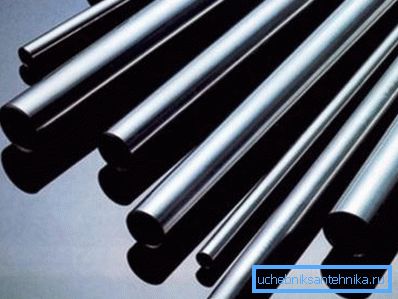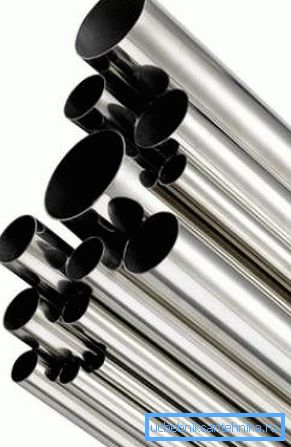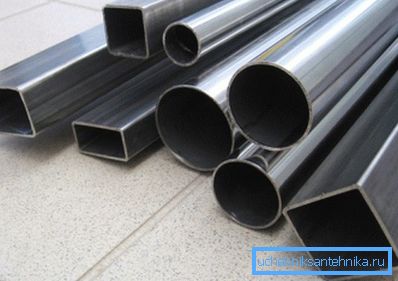Thin-walled tube - disassemble all its features
In a wide variety of products represented on modern construction markets, an uninitiated person in these matters may simply get confused. So, for example, a steel thin-walled tube has many features that you want to know. This is what we will tell you in our article.

Basic properties
If you have decided to purchase such a product, you need to have a complete idea about it. Only in this case, you can have a holistic opinion about it, which will allow you to decide whether you need it. Therefore, our instructions will give you complete information, due to which you can draw important conclusions.
Definition
Surely, having heard a thin-walled round tube, each person imagines a certain picture. However, in the construction sphere there is no place for subjective perception, therefore such a product must have a clear definition, expressed in numbers.
It sounds like this:
- Thin-walled profile tube is a product whose walls have a thickness of less than 1.5 mm. The ratio of the diameter to the thickness of the walls should be in the range of 12.5-40.
- In addition, there are also very thin-walled electric welded pipes.. They have a ratio of diameter to wall thickness of more than 40. Of course, the manufacturing technology is very limited.

They are made primarily of stainless steel, since only such a material can provide the necessary strength. However, there are other options for execution. So, often there is also a copper variety.
Scope of application
Where can metal thin-walled pipes be used? In fact, quite a lot of options.
They are used where a combination of low weight and strength is required, namely:
- Furniture manufacturing. Chrome samples are often used as decorative elements.
- Creating railings and racks. Many people recently began to give preference to just such material, having forgotten about wood. This is primarily due to a long service life.
Interesting: often these very samples are used to create railings on boats and yachts.
- Production of various metalwork, which should not be a serious burden. Do not forget that the thin-walled stainless pipe is less durable than its “brothers”.

- Aviation. With the help of such products make various pneumatic and hydraulic structures. Mostly used seamless patterns.
- Automotive industry.
- In addition, they are used in chemical laboratories for storing various substances. Here to the fore such properties as tightness and reasonable price.
Varieties regarding production method
All thin-walled pipes according to GOST can be manufactured in the following ways:
- Electric welding.
- Hot deformation.
- Cold deformation.
Note! In the latter two cases, seamless products are obtained.
Next we look at each of the production methods.
Electric welding
Such technology in the majority assumes production from a stainless steel.
So, the creation process looks like this:
- The steel sheet is cut into narrow strips, which are subsequently transformed into tape.
- Then the thin-walled pipes are welded. It can be carried out by various methods, but the following are the most popular: TIG (using an arc in inert gases) and HF (here high-frequency induction currents are used).

Important: the products welded by the first method are more durable, so it is precisely that they are acquired in cases where the structure must withstand mechanical loads. However, the lion's share of production falls on the second method, since it is much simpler and cheaper. In addition, the majority of consumers of such goods acquire it as a decorative element or for structures without load.
- Then the workpiece is subjected to cooling and flaw detection. This measure allows you to verify its quality and tightness of the seam.
- Next, the workpiece is calibrated in the mill. Then it is cut into elements of the required length.
- At the end, experienced craftsmen do visual analysis with their own hands.
Seamless hot formed
Here, a monolithic steel cylinder is taken as the raw material.
So, the sequence looks like this:
- The billet is sent to the furnace. There it is heated to the temperature of recrystallization.
- After that, with the help of a piercing press, it is turned into a hollow cylinder (sleeve). At this stage, it has an irregular shape and size.

- Further, this blank passes through various rolls for pipes, as a result of which certain dimensions are given (wall thickness and internal diameter).
- Then it is allowed to cool, and then cut and packaged.
Seamless cold
The most common model of this variety is 30HGSA. The method of production has the same features as the previous one.
However, there are two major differences:
- Upon completion of the firmware sleeve is subjected to cooling. As a result, all the rollers it passes at a relative low temperature.
- At the final stage, the workpiece is subjected to heat treatment, after which it is again calibrated. Such a measure allows for better ductility and toughness, since internal stress is relieved. (See also the Hot-Deformed Pipe: Features.)

In conclusion
That ended our story, but we made sure that you get the most complete range of knowledge. In the presented video in this article you will find additional information on this topic. Viewing this video will allow to understand all the nuances.